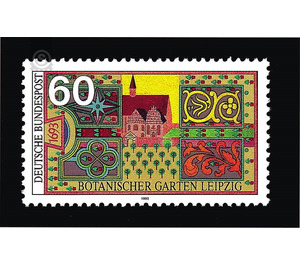Nature and environmental protection: Botanical Garden, Leipzig - Germany / Federal Republic of Germany 1992 - 60 Pfennig
Theme: Architecture
| Country | Germany / Federal Republic of Germany |
| Issue Date | 1992 |
| Face Value | 60.00 |
| Color | multi-colored yellow |
| Perforation | K 13:12 1/2 |
| Printing Type | Multicolor offset printing |
| Stamp Type | Postage stamp |
| Item Type | Stamp |
| Chronological Issue Number | 1495 |
| Chronological Chapter | GER-BRD |
| SID | 550421 |
| In 44 Wishlists | |
The expansion of the world view by the geographical discoveries in the Renaissance time also brought the botanical sciences a considerable increase in knowledge. Many unknown plants from the new areas came to Europe, where they sought their culture. Since botany was at the service of medicine at universities at that time, medicinal plants were the primary object of contemplation. To demonstrate to the students, the universities needed gardens where they could be bred. These facilities, known as Hortus medicus, originated as precursors of botanical gardens around the mid-16th century in northern Italy. Thus, in 1543, the garden of the University of Pisa was founded, in 1545 that of Florence and the famous "Hortus sphaericus" of Padua, still standing today. Their models were the medieval monastery gardens and private herb gardens, as they were created by doctors and pharmacists who cultivated therein the necessary plants for the preparation of their herbs. In Germany, Alma mater lipsiensis, founded in 1409, seems to have played a significant role in the development of Horti medici, although we do not know the exact year when the garden was founded. Some sources indicate 1542, others 1580. It can be assumed that in 1542 the wish of the Medical Faculty to the sovereign, the Saxon Duke Moritz, was expressed to want to establish a Hortus medicus, when the Duke of the University would hand over the secularized Pauline Monastery with the associated monastery gardens. The transfer of the monastery with his possession of the university was completed in 1543. From this time to 1580 the garden must have been furnished, because 1580 became with Moritz Steinmetz for him the first director appointed. Whether in 1580 or earlier, the Hortus medicus lipsiensis is thus the oldest botanical garden of a German university, which has survived to the present day with the exception of a brief interruption at the end of the Thirty Years' War, albeit with a three-fold change to a new one Terrain. It gave impulses for the investment of further Horti medici at German universities. So z. For example, the university gardens in Gießen (1609) and Altdorf near Nuremberg (1626) were founded by the Leipzig botanist Ludwig Jungermann, who became acquainted with the Hortus medicus in his hometown during his studies at the end of the 16th century. Also for the first culture of some non-native plants in Germany, the garden was important. The horse chestnut tree originating from southeastern Europe, now everywhere planted B. already cultivated in 1675 in Leipzig. Until the end of the Thirty Years' War, the garden was located between the University Church and the Grimma Gate in front of the city wall. In 1648 he was transferred to the neighboring area between church and princely house, where he held his position until 1806. The third garden was an 11-acre site with two extensive ponds in the Pleißenaue on the southwest edge of the city. From there, in 1876, he had to move to the present site on Linnéstraße. Unfortunately, they did not opt for a generous, representative facility, but only for a terrain of 3 hectares. It was merely intended to depict the "vegetation background" of the botanical institute on the same site, which gained world recognition through its famous phytosociological school of its directors Wilhelm Pfeffer and Wilhelm Ruhland. During the Second World War, the Botanical Institute and the greenhouses of the garden were almost completely destroyed. In laborious work succeeded until 1954, the reconstruction of the greenhouses. In the next few years, the generous reconstruction of the facility is planned, which should also include an enlargement of the greenhouse area and an extension of the outdoor area. Currently around 9,000 plant species are cultivated in the garden. 8 showhouses contain rainforest plants, tropical crops, Neotropic plants, palm trees, tropical water and swamp plants, laurel forests and hard-leaf formations, as well as tropical-subtropical dry vegetation plants (cacti and other succulents). Special collections are dedicated to the plants of South America, especially those of Peru. In the outdoor area, an extensive systematic department is the center, surrounded by stocks arranged according to geographic or ecological criteria. The garden is used for teaching and research, but is also a popular educational and leisure center for the inhabitants of Leipzig and their visitors. (Text: Prof. Dr. habil. G. K. Müller, Director of the Botanical Garden Leipzig)


